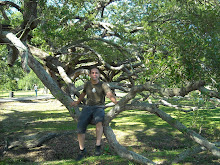Please click on the images for larger, more-detailed versions.
This person is dressed as a Mardi Gras Indian. The Mardi Gras Indians are black, working class people who, 100 years ago, realized they would never get into the Krewes that participated in Mardi Gras parades and social events and so started their own. They created personas in homage to Native Americans as some of the first people near New Orleans to help slaves get to freedom. Some of the original Mardi Gras Indians may have been former slaves.
Unlike the other parades, the Mardi Gras Indians do not have a planned or defined route. It happens when and where their "Big Chief" decides.
Decades before gangs, the Indian parades were events in which tribal groups and individuals aired grievances. It was violent and chaotic. The police could do nothing in the pandemonium that is
Mardi Gras. Also, originally the Indians were masked.
The act of dressing this way on Mardi Gras Day is called "suiting". Again, decades ago, having someone in your family suiting on Mardi Gras day was equivalent to seeing them dress in the colors of Crips or Bloods. It only meant trouble. Big Chief Tootie Montana settled all that down and now the Indian parades are heralded as a great cultural event, though still not many white people attend. The chiefs of the tribes spend all year making the suits and can use tens of thousands of beads and innumerable feathers. The suits can cost upwards of $20,000 to make. The suits are only used once and often go directly to museums.
The Back of the shirt reads: "Won't Bow Down" from the song, "My Indian Red".
"I've got a Big Chief, Big Chief, Big Chief of the Nation
Wild, wild creation
He won't bow down, down on the ground
Oh how I love to hear him call Indian Red
When I throw my net in the river
I will take only what I need
Just enough for me and my lover
I will take only what I need
Mighty cooty fiyo - hey la hey, hey la he"
In 1976, the "The Wild Tchoupitoulas" tribe made an album of "call-and-response" songs with famed New Orleans producer Allen Toussaint and members of the musical groups The Meters (you know "Cissy Strut") and the Neville Brothers (nephews of Wild Tchoupitoulas' leader George "Big Chief Jolly" Landry.
There are volumes to be read about the customs, behaviors and dress style of the different tribes- how they great each other with songs or acquiesce to a rival's superior suit craftsmanship and what-have-you. I won't load this post up with details, but I encourage you to look them up. I would just have to Google for more information, anyway. At least do an "image search".
A few related Links:
Andrew Justin: Runnin' Pretty
Krewe of Zulu
The World That Made New Orleans
Wewontbowdown.com
Mardigrasneworleans.com/Indians


